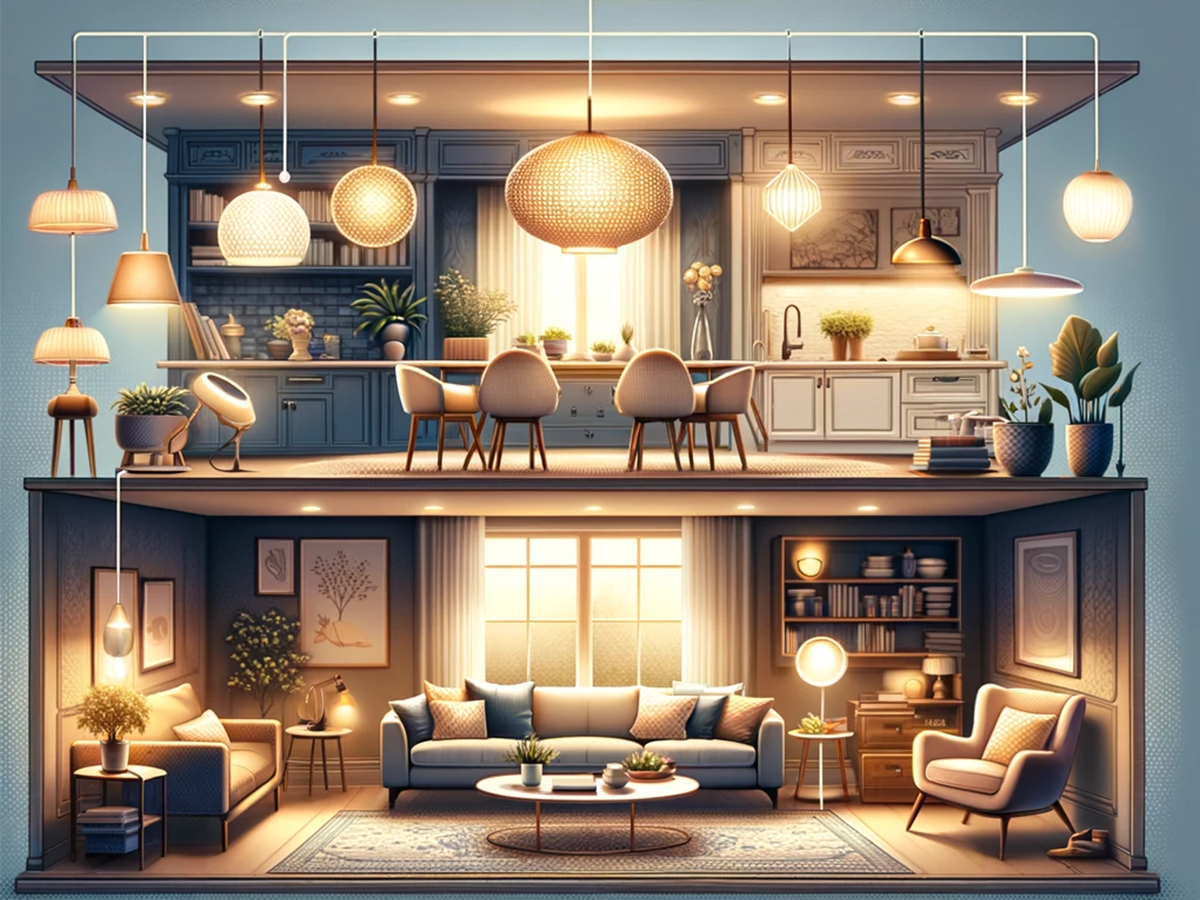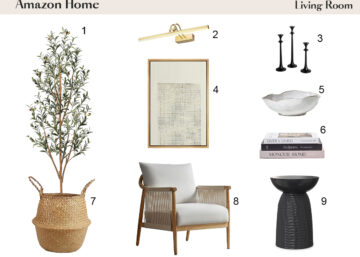Lighting Layers: Ambient, Task, and Accent Lighting Explained
In the realm of interior design, lighting serves as the unsung hero, silently shaping the ambiance and functionality of every space. Beyond its utilitarian purpose, lighting holds the power to transform ordinary rooms into extraordinary environments, inviting occupants on a journey of sensory discovery. This article delves into the intricate world of lighting layers, exploring the nuances of ambient, task, and accent lighting, and uncovering innovative approaches to illuminate spaces with precision and finesse. Join us as we unravel the mysteries of lighting design and embark on a quest to illuminate the path to extraordinary interiors.
Ambient Lighting
Ambient lighting serves as the foundation of any well-designed interior space, providing overall illumination and setting the mood for the room. While its primary purpose is to create a comfortable and inviting atmosphere, there are several unique considerations and applications of ambient lighting that are often overlooked in traditional discussions of lighting design.
Understanding Ambient Lighting
Ambient lighting, also known as general lighting, is the uniform illumination that fills a room without creating harsh shadows or glare. It ensures that the entire space is adequately lit, allowing occupants to navigate and perform tasks comfortably. Traditionally, ambient lighting has been achieved through ceiling-mounted fixtures such as recessed lights, flush mounts, or pendant lights, but there are alternative methods that can enhance its effectiveness and aesthetic appeal.
Natural Light Integration
One often overlooked aspect of ambient lighting is the integration of natural light sources, such as windows, skylights, or light wells. Harnessing natural light not only reduces the reliance on artificial lighting but also introduces dynamic changes in illumination throughout the day. By strategically positioning windows and incorporating light-diffusing elements like sheer curtains or frosted glass, designers can control the intensity and distribution of natural light to create a harmonious blend with artificial ambient lighting.
Layering Ambient Light
Another unique approach to ambient lighting is the concept of layering light sources to create depth and visual interest in the space. Instead of relying solely on overhead fixtures, designers can incorporate multiple light sources at varying heights and levels of intensity. This may include wall sconces, floor lamps, or even indirect lighting techniques such as cove lighting or uplighting. By layering ambient light sources, designers can achieve a more nuanced and inviting ambiance while minimizing glare and shadows.
Color Temperature Considerations
In addition to traditional considerations such as brightness and distribution, designers should also pay attention to the color temperature of ambient lighting sources. Warm color temperatures (e.g., 2700K-3000K) tend to create a cozy and inviting atmosphere, while cooler temperatures (e.g., 4000K-5000K) can evoke a sense of spaciousness and clarity. By carefully selecting light sources with appropriate color temperatures, designers can tailor the ambient lighting to suit the desired mood and function of the space.
In summary, ambient lighting plays a crucial role in creating a welcoming and functional environment, but its potential goes beyond traditional ceiling-mounted fixtures. By integrating natural light, layering light sources, and considering color temperature, designers can elevate the ambiance of a space and create a truly immersive lighting experience for occupants.
Task Lighting: Shedding Light on Purposeful Illumination
Task lighting plays a pivotal role in illuminating specific areas or tasks within a space, providing focused and directed light to enhance productivity and comfort. While often overshadowed by ambient and accent lighting, the strategic integration of task lighting can significantly elevate the functionality and aesthetics of interior environments. In this section, we delve into the nuances of task lighting, exploring its diverse applications and innovative design approaches.
Defining Task Lighting
Task lighting refers to localized illumination designed to facilitate specific activities, such as reading, cooking, or working at a desk. Unlike ambient lighting, which provides overall illumination, task lighting targets particular areas where focused light is needed to perform tasks with precision and clarity. By eliminating shadows and reducing eye strain, task lighting enhances productivity and creates a comfortable environment for occupants.
Applications of Task Lighting
Task lighting finds application in various settings, from residential interiors to commercial spaces, where specific tasks require heightened visibility and attention to detail. In residential kitchens, under-cabinet lighting illuminates countertops and cooking surfaces, while pendant lights or adjustable wall sconces provide focused light for food preparation areas. In office environments, task lighting solutions such as desk lamps or overhead track lighting ensure optimal lighting conditions for reading, writing, or computer work.
Innovative Design Approaches
Designers are continuously exploring innovative approaches to integrate task lighting seamlessly into interior spaces, balancing functionality with aesthetics. Adjustable fixtures, such as swing-arm wall lamps or articulating desk lamps, offer flexibility in directing light precisely where it’s needed, adapting to changing tasks or occupant preferences. Built-in lighting solutions, such as recessed LED strip lights or integrated shelf lighting, provide discreet illumination without cluttering the visual landscape, ideal for minimalist or contemporary design schemes.
Task Lighting for Specialized Environments
Certain environments require specialized task lighting solutions tailored to specific activities or user needs. In healthcare facilities, for example, task lighting in examination rooms or surgical suites must meet stringent requirements for brightness, color rendering, and glare control to support medical procedures and ensure patient safety. In art studios or galleries, adjustable track lighting or gallery-style picture lights are employed to highlight artwork and create visual focal points while preserving the integrity of colors and textures.
Ergonomics and Comfort
Beyond enhancing visual acuity, task lighting contributes to ergonomic comfort by reducing eye strain and fatigue associated with prolonged task performance. Properly positioned task lighting fixtures minimize glare and shadows, allowing users to work comfortably for extended periods without experiencing discomfort or visual discomfort. By promoting optimal lighting conditions, designers prioritize occupant well-being and productivity, fostering a conducive environment for work, study, or leisure activities.
Accent Lighting: Illuminating the Extraordinary
Accent lighting serves as the secret weapon in interior design, adding depth, drama, and visual interest to architectural features, artwork, or focal points within a space. While often overshadowed by ambient and task lighting, accent lighting plays a crucial role in creating ambiance and highlighting the unique character of a room. In this section, we explore the transformative power of accent lighting and innovative strategies for incorporating it into interior environments.
Understanding Accent Lighting
Accent lighting is a specialized form of illumination designed to draw attention to specific objects or areas within a space, creating visual focal points and enhancing the overall aesthetic appeal. Unlike ambient or task lighting, which provides general or task-oriented illumination, accent lighting is focused and directional, allowing designers to sculpt light and shadow to dramatic effect. By strategically positioning accent lighting fixtures, designers can highlight architectural details, artwork, or decorative elements, adding depth and dimension to the space.
Creating Visual Focal Points
One of the primary functions of accent lighting is to create visual focal points that command attention and evoke emotional responses from occupants. Whether it’s a striking piece of artwork, a sculptural feature, or an architectural detail, accent lighting can accentuate its unique qualities and create a sense of drama and intrigue. By casting focused beams of light or creating pools of light and shadow, designers can sculpt the visual landscape and guide the eye towards areas of interest, enhancing the overall narrative and atmosphere of the space.
Types of Accent Lighting Fixtures
Accent lighting fixtures come in a variety of forms, each offering unique opportunities for creative expression and visual impact. Adjustable track lights, for example, allow designers to precisely position light sources and customize the angle and intensity of illumination to highlight specific objects or areas. Wall-mounted picture lights or uplights can be used to showcase artwork or architectural features, while recessed adjustable downlights provide discreet yet effective accent lighting for alcoves or niches.
Layering Light for Dimension
To maximize the impact of accent lighting, designers often employ a technique known as light layering, which involves combining multiple light sources at different levels and intensities to create depth and dimension in the space. By layering ambient, task, and accent lighting, designers can sculpt the visual environment, accentuating textures, shapes, and colors, and creating a dynamic interplay of light and shadow. This multidimensional approach to lighting design enhances the overall ambiance and visual interest of the space, elevating its aesthetic appeal and creating memorable experiences for occupants.
Incorporating Accent Lighting into Design Schemes
When incorporating accent lighting into design schemes, designers should consider the unique characteristics of the space and the desired effect they wish to achieve. Whether it’s creating a dramatic focal point in a living room, highlighting architectural features in a commercial space, or adding sparkle to a retail display, accent lighting offers endless possibilities for creative expression. By understanding the principles of light and shadow and embracing innovative lighting solutions, designers can transform ordinary environments into extraordinary experiences, leaving a lasting impression on occupants and visitors alike.
Layering Light: Design Tips
In the intricate dance of lighting design, layering light is akin to composing a symphony, where each element harmonizes to create a captivating and dynamic experience. By strategically integrating ambient, task, and accent lighting, designers can sculpt the ambiance, enhance functionality, and evoke emotions within interior spaces. In this section, we delve into innovative design tips for effectively layering light, exploring unique techniques and considerations that elevate the art of illumination to new heights.
Understanding the Principles of Light Layering
Before delving into specific design tips, it’s essential to understand the fundamental principles of light layering and its role in shaping the visual environment. Light layering involves the strategic placement of multiple light sources at different levels and intensities to create depth, contrast, and visual interest within a space. By carefully balancing ambient, task, and accent lighting, designers can transform ordinary spaces into extraordinary environments that captivate the senses and engage the imagination.
Tip 1: Start with Ambient Lighting as the Foundation
Ambient lighting serves as the foundation of any lighting design scheme, providing overall illumination and establishing the mood for the space. When layering light, begin by ensuring that the ambient lighting is evenly distributed throughout the room, using fixtures such as recessed lights, flush mounts, or chandeliers to create a soft, diffused glow. By establishing a comfortable and inviting ambiance with ambient lighting, designers set the stage for the layers of light to come.
Tip 2: Layer Task Lighting for Functionality and Comfort
Once the ambient lighting is in place, layer task lighting to enhance functionality and comfort within specific areas of the room. Task lighting fixtures, such as desk lamps, under-cabinet lights, or adjustable wall sconces, should be strategically positioned to provide focused illumination for activities such as reading, cooking, or working. By layering task lighting, designers ensure that occupants have adequate visibility and clarity to perform tasks with ease and precision.
Tip 3: Add Accent Lighting for Drama and Visual Interest
To elevate the ambiance and create visual focal points within the space, layer accent lighting to highlight architectural features, artwork, or decorative elements. Accent lighting fixtures, such as adjustable track lights, wall-mounted picture lights, or recessed downlights, can be used to create pools of light and shadow, adding depth and dimension to the room. By strategically positioning accent lighting, designers draw attention to specific areas or objects, creating a sense of drama and intrigue.
Tip 4: Embrace Dynamic Lighting Controls
To maximize flexibility and adaptability in lighting design, embrace dynamic lighting controls that allow for adjustable brightness, color temperature, and even lighting effects. Smart lighting systems, equipped with sensors, dimmers, and programmable controls, enable designers to create custom lighting scenes tailored to different activities, moods, or times of day. By incorporating dynamic lighting controls, designers empower occupants to personalize their lighting experience and create environments that cater to their individual needs and preferences.
Tip 5: Consider Layering with Natural Light
In addition to artificial lighting, consider layering with natural light sources such as windows, skylights, or light wells. Natural light adds a dynamic element to the layering process, introducing variations in brightness, color, and texture throughout the day. By strategically positioning windows and incorporating light-diffusing elements, designers can harness the beauty of natural light to complement and enhance the artificial lighting layers, creating a seamless and harmonious lighting experience.
Tip 6: Experiment with Texture and Materials
To further enhance the visual interest and texture within a space, experiment with lighting fixtures and materials that add depth and character to the lighting design. Incorporate fixtures with unique shapes, finishes, or materials, such as metal, glass, or wood, to create contrast and visual intrigue. Additionally, consider using lighting techniques such as uplighting, wall washing, or grazing to highlight architectural details or textured surfaces, adding richness and dimension to the overall lighting composition.
Tip 7: Balance and Harmony
Ultimately, the key to successful light layering lies in achieving balance and harmony between the different lighting elements. Pay attention to the interplay of light and shadow, ensuring that each layer complements and enhances the others without overpowering the space. By carefully orchestrating the layers of light, designers can create immersive environments that captivate the senses and evoke a profound emotional response from occupants.
Practical Considerations for Light Layering
In the pursuit of creating stunning lighting compositions, it’s essential to balance creativity with practicality. Practical considerations play a crucial role in ensuring that lighting designs not only look aesthetically pleasing but also function effectively and meet the needs of occupants. In this section, we explore key practical considerations for light layering, from energy efficiency to maintenance requirements, providing insights that resonate with our target audience of architects, designers, and property owners.
Energy Efficiency and Sustainability
One of the foremost practical considerations in lighting design is energy efficiency and sustainability. With the growing emphasis on environmental responsibility and energy conservation, designers are increasingly turning to energy-efficient lighting solutions such as LED fixtures, compact fluorescent lamps (CFLs), and daylight harvesting systems. By selecting energy-efficient lighting sources and incorporating daylighting strategies, designers can reduce energy consumption, minimize environmental impact, and lower operating costs for building owners.
Maintenance and Accessibility
Another practical consideration for light layering is maintenance and accessibility. Lighting fixtures, particularly those installed in high-ceiling spaces or hard-to-reach areas, may require regular maintenance and servicing to ensure optimal performance and longevity. When designing lighting layouts, designers should consider ease of access for maintenance personnel and incorporate features such as removable access panels or motorized lifts for effortless lamp replacement and cleaning.
Regulatory Compliance and Safety
Designers must also adhere to regulatory codes and standards governing lighting design to ensure compliance with safety and accessibility requirements. Building codes, such as the International Energy Conservation Code (IECC) and the Americans with Disabilities Act (ADA), stipulate guidelines for lighting design, including minimum lighting levels, fixture placement, and emergency egress lighting. By staying informed about regulatory requirements and consulting with lighting specialists, designers can ensure that their lighting designs meet or exceed safety standards and regulatory compliance.
Budget and Cost Considerations
Budget constraints often play a significant role in lighting design decisions, particularly for commercial projects or renovations with limited financial resources. Designers must balance aesthetic aspirations with budgetary considerations, selecting lighting fixtures and control systems that deliver the desired visual impact within the available budget. By prioritizing lighting elements that offer the most value and investing in energy-efficient technologies with long-term cost savings, designers can achieve lighting designs that are both visually compelling and financially prudent.
User Comfort and Well-being
Finally, designers must prioritize user comfort and well-being when designing lighting layouts, considering factors such as glare control, color temperature, and circadian lighting principles. By selecting lighting sources with appropriate color rendering properties and minimizing glare through proper fixture selection and positioning, designers can create visually comfortable environments that promote occupant health, productivity, and satisfaction.
Conclusion: Enlightening Perspectives on Light Layering
In the realm of interior design, light is not merely a functional necessity but a powerful tool for shaping the ambiance, functionality, and aesthetics of spaces. Through the artful layering of ambient, task, and accent lighting, designers can orchestrate captivating visual experiences that transcend the ordinary and elevate the extraordinary. In this concluding section, we reflect on the enlightening perspectives gleaned from our exploration of light layering, reaffirming its transformative impact on interior environments.
Empowering Designers with Creative Possibilities
Light layering empowers designers with a palette of creative possibilities, allowing them to sculpt light and shadow to evoke emotions, enhance functionality, and create visual focal points within interior spaces. By embracing innovative lighting techniques and technologies, designers can unleash their creativity and bring their design visions to life with unparalleled precision and finesse.
Enhancing User Experience and Well-being
At the heart of light layering lies a commitment to enhancing user experience and well-being. By prioritizing user comfort, safety, and visual comfort, designers can create environments that foster productivity, creativity, and a sense of well-being among occupants. Through thoughtful consideration of lighting quality, color temperature, and glare control, designers can curate immersive experiences that resonate with the senses and uplift the human spirit.
Navigating Practical Realities with Grace
While creativity fuels the imagination, practical considerations provide a grounding framework for effective lighting design. From energy efficiency and maintenance to regulatory compliance and budget constraints, designers must navigate a myriad of practical realities with grace and ingenuity. By striking a delicate balance between aesthetic aspirations and practical necessities, designers can deliver lighting solutions that are not only visually stunning but also functionally efficient and financially viable.
Continued Innovation and Evolution
As technology advances and design trends evolve, the landscape of light layering continues to evolve, presenting new opportunities for innovation and exploration. From smart lighting systems and dynamic controls to sustainable lighting solutions and biophilic design principles, the future of light layering is ripe with possibilities. By embracing emerging technologies and staying abreast of industry trends, designers can continue to push the boundaries of creativity and reshape the way we experience light in the built environment.








